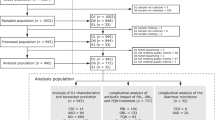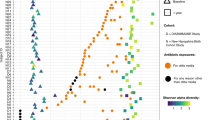Abstract
Antibiotic-associated diarrhea (AAD) is associated with altered intestinal microflora and other symptoms that may lead to possibly death. In critically ill patients, diarrhea increases rates of morbimortality. Assessing diarrhea risks is thus important for clinicians. For this reason, we conducted a hypothesis-generating study focused on AAD to provide insight into methods of prevention. We evaluated the hypothesis of predisposing factors within the resident intestinal microbiota in a cohort of outpatients receiving antibiotherapy. Among the pool of tested variables, only those related to bacterial 16S rRNA genes were found to be relevant. Complex statistical analyses provided further information: amid the bacteria 16S rRNA genes, eight were determined to be essential for diarrhea predisposition and characterized from the most important to the least. Using these markers, AAD risk could be estimated with an error of 2%. This molecular analysis offers new perspectives for clinical applications at the level of prevention.




Similar content being viewed by others
References
Arbuckle RB, Huber SL, Zacker C (2000) The consequences of diarrhea occurring during chemotherapy for colorectal cancer: a retrospective study. Oncologist 5:250–259
Bartlett JG (2002) Clinical practice. Antibiotic-associated diarrhea. N Engl J Med 346:334–339
Bartlett JG (2002) Clostridium difficile-associated enteric disease. Curr Infect Dis Rep 4:477–483
Beaugerie L, Flahault A, Barbut F, Atlan P, Lalande V, Cousin P, Cadilhac M, Petit JC (2003) Antibiotic-associated diarrhoea and Clostridium difficile in the community. Aliment Pharmacol Ther 17:905–912
Blakelock RT, Beasley SW (2003) Infection and the gut. Semin Pediatr Surg 12:265–274
Bosshard PP, Abels S, Zbinden R, Bottger EC, Altwegg M (2003) Ribosomal DNA sequencing for identification of aerobic gram-positive rods in the clinical laboratory (an 18-month evaluation). J Clin Microbiol 41:4134–4140
Collier CT, Hofacre CL, Payne AM, Anderson DB, Kaiser P, Mackie RI, Gaskins HR (2008) Coccidia-induced mucogenesis promotes the onset of necrotic enteritis by supporting Clostridium perfringens growth. Vet Immunol Immunopathol 122:104–115
De La Cochetiere MF, Durand T, Lalande V, Petit JC, Potel G, Beaugerie L (2008) Effect of antibiotic therapy on human fecal microbiota and the relation to the development of Clostridium difficile. Microb Ecol 56:395–402
De La Cochetiere MF, Piloquet H, des Robert C, Darmaun D, Galmiche JP, Roze JC (2004) Early intestinal bacterial colonization and necrotizing enterocolitis in premature infants: the putative role of Clostridium. Pediatr Res 56:366–370
Dethlefsen L, Huse S, Sogin ML, Relman DA (2008) The pervasive effects of an antibiotic on the human gut microbiota, as revealed by deep 16S rRNA sequencing. PLoS Biol 6:e280
Eckburg PB, Bik EM, Bernstein CN, Purdom E, Dethlefsen L, Sargent M, Gill SR, Nelson KE, Relman DA (2005) Diversity of the human intestinal microbial flora. Science 308:1635–1638
Hooper LV, Wong MH, Thelin A, Hansson L, Falk PG, Gordon JI (2001) Molecular analysis of commensal host-microbial relationships in the intestine. Science 291:881–884
Hrncir T, Stepankova R, Kozakova H, Hudcovic T, Tlaskalova-Hogenova H (2008) Gut microbiota and lipopolysaccharide content of the diet influence development of regulatory T cells: studies in germ-free mice. BMC Immunol 9:65
Huys G, Vanhoutte T, Vandamme P (2008) Application of sequence-dependent electrophoresis fingerprinting in exploring biodiversity and population dynamics of human intestinal microbiota: what can be revealed? Interdiscip Perspect Infect Dis 2008:597–603
Iapichino G, Callegari ML, Marzorati S, Cigada M, Corbella D, Ferrari S, Morelli L (2008) Impact of antibiotics on the gut microbiota of critically ill patients. J Med Microbiol 57:1007–1014
Janda JM, Abbott SL (2007) 16S rRNA gene sequencing for bacterial identification in the diagnostic laboratory: pluses, perils, and pitfalls. J Clin Microbiol 45:2761–2764
Johnston BC, Supina AL, Ospina M, Vohra S (2007) Probiotics for the prevention of pediatric antibiotic-associated diarrhea. Cochrane Database Syst Rev:CD004827
La Scola B, Gundi VA, Khamis A, Raoult D (2006) Sequencing of the rpoB gene and flanking spacers for molecular identification of Acinetobacter species. J Clin Microbiol 44:827–832
Lepage P, Seksik P, Sutren M, de la Cochetiere MF, Jian R, Marteau P, Dore J (2005) Biodiversity of the mucosa-associated microbiota is stable along the distal digestive tract in healthy individuals and patients with IBD. Inflamm Bowel Dis 11:473–480
Manichanh C, Varela E, Martinez C, Antolin M, Llopis M, Dore J, Giralt J, Guarner F, Malagelada JR (2008) The gut microbiota predispose to the pathophysiology of acute postradiotherapy diarrhea. Am J Gastroenterol 103:1754–1761
Martens H, Veflingstad SR, Plahte E, Martens M, Bertrand D, Omholt SW (2009) The genotype–phenotype relationship in multicellular pattern-generating models—the neglected role of pattern descriptors. BMC Syst Biol 3:87
McFarland LV (2008) Antibiotic-associated diarrhea: epidemiology, trends and treatment. Future Microbiol 3:563–578
Seksik P, Lepage P, de la Cochetiere MF, Bourreille A, Sutren M, Galmiche JP, Dore J, Marteau P (2005) Search for localized dysbiosis in Crohn's disease ulcerations by temporal temperature gradient gel electrophoresis of 16S rRNA. J Clin Microbiol 43:4654–4658
Simmon KE, Croft AC, Petti CA (2006) Application of SmartGene IDNS software to partial 16S rRNA gene sequences for a diverse group of bacteria in a clinical laboratory. J Clin Microbiol 44:4400–4406
Simmon KE, Mirrett S, Reller LB, Petti CA (2008) Genotypic diversity of anaerobic isolates from bloodstream infections. J Clin Microbiol 46:1596–1601
Stringer AM, Gibson RJ, Bowen JM, Keefe DM, Logan RM, Yeoh AS, Hamilton J (2009) Chemotherapy-induced modifications to gastrointestinal microflora: evidence and implications of change gastrointestinal microflora and mucins may play a critical role in the development of 5-fluorouracil-induced gastrointestinal mucositis. Curr Drug Metab 10:79–83
Stringer AM, Gibson RJ, Bowen JM, Logan RM, Yeoh AS, Keefe DM (2007) Chemotherapy-induced mucositis: the role of gastrointestinal microflora and mucins in the luminal environment. J Support Oncol 5:259–267
Suau A, Bonnet R, Sutren M, Godon JJ, Gibson GR, Collins MD, Dore J (1999) Direct analysis of genes encoding 16S rRNA from complex communities reveals many novel molecular species within the human gut. Appl Environ Microbiol 65:4799–4807
Tannock GW (2001) Molecular assessment of intestinal microflora. Am J Clin Nutr 73:410S–414S
Tannock GW (2007) What immunologists should know about bacterial communities of the human bowel. Semin Immunol 19:94–105
Wistrom J, Norrby SR, Myhre EB, Eriksson S, Granstrom G, Lagergren L, Englund G, Nord CE, Svenungsson B (2001) Frequency of antibiotic-associated diarrhoea in 2462 antibiotic-treated hospitalized patients: a prospective study. J Antimicrob Chemother 47:43–50
Zoetendal EG, Akkermans AD, De Vos WM (1998) Temperature gradient gel electrophoresis analysis of 16S rRNA from human fecal samples reveals stable and host-specific communities of active bacteria. Appl Environ Microbiol 64:3854–3859
Acknowledgments
We thank Dr. Bertrand D. from INRA, Unité de Sensometrie-Chimiometrie (Nantes, France) for his assistance in this investigation.
Financial support
Biocodex, Inc.
Potential conflicts of interest
The authors declare no conflict of interest.
Author information
Authors and Affiliations
Corresponding author
Rights and permissions
About this article
Cite this article
de La Cochetière, MF., Montassier, E., Hardouin, JB. et al. Human Intestinal Microbiota Gene Risk Factors for Antibiotic-Associated Diarrhea: Perspectives for Prevention. Microb Ecol 59, 830–837 (2010). https://doi.org/10.1007/s00248-010-9637-2
Received:
Accepted:
Published:
Issue Date:
DOI: https://doi.org/10.1007/s00248-010-9637-2




